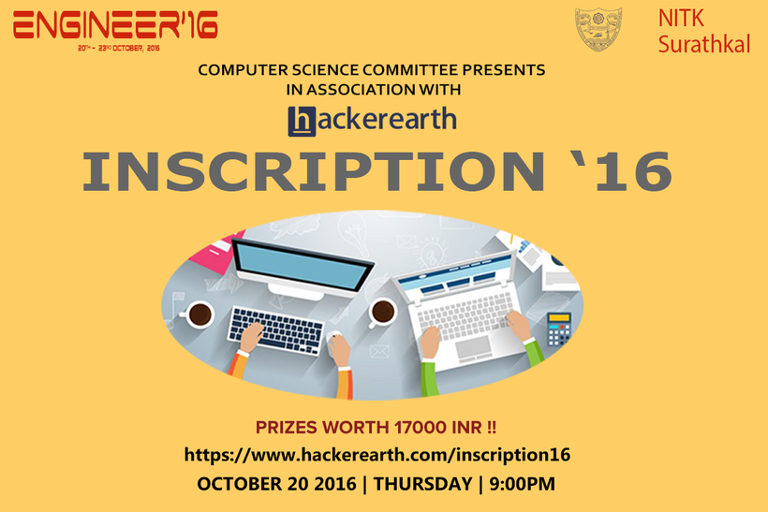Engineer, the annual technical fest of NITK, Surathkal, in association with HackerEarth presents Inscription, the online algorithmic programming contest of NITK. It is also the flagship event of Engineer's Computer Science Events' Committee. The previous editions of the event witnessed tons of participants from various countries and also successfully managed to attract some of the best coders of the world to compete for the top spot. This year once again Inscription strives to achieve its previous glory.

The details of the competition are as follows:
Timings : 10.30 PM IST (20-OCT-16) to 10.30 PM IST (21-OCT-16) (Check your timezone here)
Contest Link : https://www.hackerearth.com/inscription16
Prizes only for top 3 Indian winners.
- First Prize : 8000 INR
- Second Prize : 6000 INR
- Third Prize : 3000 INR
To be eligible for prizes, please fill the form : https://goo.gl/forms/jmF7VpKDSbN1dv9r2
There will be 12 questions of varying difficulty levels, and you will have 24 hours to solve them. We have tried our best to create an interesting problemset, and we hope that everyone finds something interesting in the tasks. Most of the tasks will have partial scoring, and editorials will be published for all of them at the end of the contest.
We hope you'll have an amazing time! Happy Coding!! :)
Reminder : The contest begins in less than 6 hours!!
Update 1: The contest has been delayed by 1:30 hours to avoid clash with Amritapuri ICPC Preparatory Contest. The contest will now begin at 10:30 pm IST.
Update 2: We're halfway through the contest, and there are 4 problems yet to be solved. Are you up for the challenge? It's still not late to start!
Update 3: The contest has ended successfully. The problems have been moved to Practice section. The editorials for most of the problems have been published. The editorials for Geeky Friendship Gift, Rescue Cricket and Mike's visit to a black hole will be updated soon.
Hope you had fun! Please spare some time to fill the feedback form : Feedback Form :)










We will like to participate if you promise that problem statements will be understandable and editorial for each problem will be posted after the contest ends.
Link to previous contests is here and here . most of the authors are same. I think questions are pretty clear and understandable.
Can this be delayed by 1:30-2 hours?
Amritapuri practice contest ends at 10 pm, and I think many Indian teams will be participating.
Thanks. :) We have delayed the contest by 1:30 hours.
Nice questions.. Expected solution for Geeky Gift? I could answer queries in O(log^2N) but that TLE'd
It can be solved in O( N*logN*67+ Q*logn + Q*67) . Though it just passes all the tests . Code : http://ideone.com/loLaMW
Maybe I got a bit too lazy in coding it up entirely. The O(NlogN * 67 + Q * 67) was simple sparse table right ? The other part is persistent?
Yeah , sparse table . But to reduce memory char had to be used instead of int . The other part is just persistent segment tree .
The expected solution requires O(logN) per query and O(Nlog^2N) for preprocessing. Code : http://ideone.com/AiBVyc
What was the approach for "Richard's Gold Experiment" ?
The problem can be solved by greedy approach. Here is the detailed editorial.
Why are the problems not available for practice? :/
The problems are now available for practice.